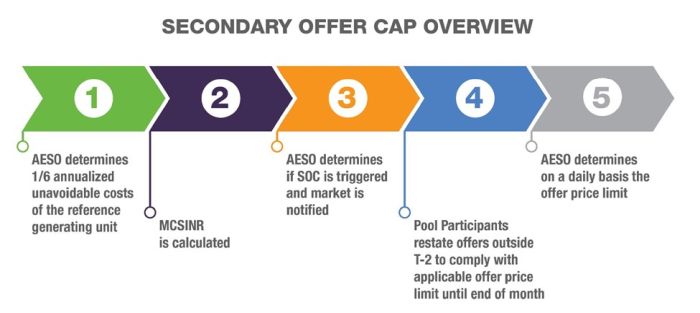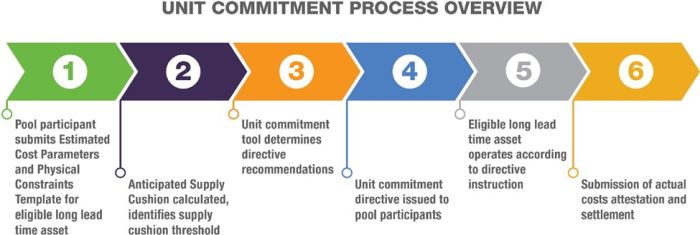On June 11, 2024, the Alberta Electric System Operator (AESO) held its final stakeholder session with respect to the implementation of the Interim Market Power Mitigation as part of the efforts towards the Restructured Energy Market (REM). This session focused on the implementation process of the Interim Market Power Mitigation Measures. While the broader discussion on the AESO's REM recommendations was not included, an update regarding economic withholding was provided. This blog post provides a summary of the sessions key points.
On June 14, 2024, the AESO will submit an expedited filing for the proposed new and amended ISO rules, designed to support the Market Power Mitigation Regulation (MPM Regulation) and the Supply Cushion Regulation. ISO Rule 206.1, the Interim Secondary Offer Cap, will align with the MPM Regulation, and ISO Rule 206.2, the Interim Supply Cushion Directives, will align with the Supply Cushion Regulation. Additionally, the AESO is set to introduce a series of new definitions to the Consolidated Authoritative Document Glossary (CADG).
The majority of these changes are intended to become effective on July 1, 2024. However, it is important to note that pool participants who fall under the purview of Rule 206.2 are required to submit their Estimated Cost Parameters and Physical Constraint Templates (Templates) by June 21, 2024.
We previously provided an overview of the rationale behind REM, informed by the insights and recommendations from the Alberta Market Surveillance Administrator and AESO Reports which can be read here. Additionally, an overview of the Interim Market Power Mitigation Measures which can be read here.
Update on Economic Withholding
On May 17, 2024, the AESO engaged in consultation with chief executive officers from key industries to discuss potential changes to the energy market's pricing framework. The feedback received indicated a preference among some stakeholders to include economic withholding provisions in the energy market's design.
The AESO presented this alternative to the Province of Alberta (Province) for consideration. The decision on whether to adopt an alternative approach or to continue with the current proposed REM model rests with the Province. The AESO communicated that it is waiting on a policy decision on this matter and hopes to gain clarity in the near future. Once the AESO receives the Province's direction, the engagement schedule will be finalized. The policy decision, however, could potentially affect initial plans to commence stakeholder engagement by July 2024.
MPM Regulation
The MPM Regulation requires the ISO to calculate Monthly Cumulative Settlement Interval Net Revenue (MCSINR) and to enforce a secondary offer cap (SOC) when revenue exceeds certain limits. The AESO has compiled a document detailing the proposed amendments in Information Document #2024-004.
The five-step process (as presented the AESO's stakeholder session and presentation) is discussed below:
Step 1:
The AESO will calculate the one-sixth (1/6th) annualized unavoidable cost for the reference generating unit. This figure will be determined at the start of each month and then posted on AESO's website. The calculated cost will stay consistent throughout the entire month but may vary from month to month.
Step 2:
The AESO is responsible for calculating the MCSINR of the reference generating unit for each settlement interval. Every hour (i.e., the current definition of settlement interval), the AESO will calculate the MCSINR of the reference generating unit. The AESO has indicated that typically, this takes about 15 minutes following the close of the settlement interval.
The AESO will not calculate the MCSINR during the final 20 minutes of a settlement interval. Consequently, the SOC will not be activated in this 20-minute window. If there is a delay in receiving data, such as the pool price, and it only becomes available within the last 20 minutes of an hour, the MCSINR calculation will be postponed to the start of the next settlement interval. This adjustment ensures that market participants will always have a minimum of 20 minutes from the time they are notified to make restatements.
Step 3:
If the MCSINR surpasses one-sixth (1/6th) of the annualized unavoidable costs, the SOC is activated, instituting a SOC limit for settlement intervals occurring more than two (2) hours after the notification. The AESO will inform pool participants when they need to adjust their offer prices to comply with this limit. Once triggered, the SOC remains in effect until the end of the month.
Step 4:
Pool participants who control more than 5% of the offer capacity must adjust their thermal offers to meet the specified offer price limit. Then these participants will be obligated to maintain their offers at or below this limit for the rest of the month.
Step 5:
Once the SOC is activated, the AESO will set daily secondary offer price limits, which will be the greater of 25 times the day-ahead gas price (as per the ICE NGX AB-NIT Day Ahead Index) or $125. The limit for the following day is determined after the day-ahead gas price is available. These limits can vary each day and become effective at the beginning of the gas day. The AESO will continue to calculate and post these limits throughout the duration of the month in which the SOC was triggered.
These steps are simplified in the following illustration provided by the AESO:

Reporting and Notification:
The AESO has developed three new Energy Trading System (ETS) reports designed to present information pertinent to the SOC and the MCSINR. To fulfill the reporting and notification obligations stipulated under section 206.1 of the ISO rules, the AESO is utilizing these reports to effectively communicate with pool participants. These new reports are:
MCSINR Report: This will be available both in current and historical version. It will automatically refresh and will be viewable without data on June 20, 2024.
Secondary Offer Price Limit Report: This will be available both in current and historical versions.
MCSINR and Secondary Offer Price Limit Report: This will be viewable on the ETS main landing page.
In addition, the AESO is exploring additional methods of notifying market participants. Specifically, the AESO is considering the implementation of an automatic notification via the Automated Dispatch and Message System (ADaMS) that would be trigger an alert to participants when the SOC is activated.
Supply Chain Cushion
Under the Supply Cushion Regulation, if the supply cushion falls below 932 megawatts, the AESO is required to issue unit commitment directives to certain market participants. These directives target eligible long lead time assets, such as power generation facilities that require significant time to start up or shut down.
New ISO Rule 206.2, in conjunction with its related CADG definitions, are intended to enhance the Supply Cushion Regulation by:
- establishing clear guidelines for pool participants with eligible long lead time assets to submit their projected operational costs and physical limitations;
- requiring the AESO to transparently communicate the methodology it employs to estimate the supply cushion; and
- setting forth the procedures for pool participants to report the actual costs resulting from compliance with unit commitment directives. This process will also include the stipulation for a cost attestation to qualify for a cost guarantee.
The AESO has compiled an in-depth document detailing the proposed amendments, and the associated draft Templates can be located within Information Document #2024-005 (ID#2024-005).
The table below illustrates the six-step procedure for unit commitment and each step (as presented the AESO's stakeholder session and presentation) is discussed below:

Step 1:
Market participants with eligible long lead time assets will be required under new ISO Rule 206.2, subsection 2(1), to submit their: (1) estimated costs and (2) physical constraints to the AESO. Draft form of these Templates, provided as an Excel sheet, can be viewed here and here. Pool participants with an eligible long lead time asset must:
- use the AESO's designated Templates, which will be available by June 14th, 2024; and
- complete and send the Templates via email to ucdirectives@aeso.ca no later than June 21, 2024. For any assets that become eligible subsequent to this deadline, the Templates must be submitted within 48 hours of the asset commencing commercial operations. In the event of any changes to the previously submitted information, a revised Template must be submitted to the AESO as soon as reasonably practical.
The AESO will assess the submitted templates for completeness and may request additional information or clarification. Upon approval, market participants will be notified by email, confirming the acceptance of their information for the purpose of issuing unit commitment directives.
Market participants are reminded that while they are required to submit their start-up time information under ISO Rule 206.2, they must also continue to report the initial start-up time of their assets in accordance with ISO Rule 203.1.
Step 2:
Subsection 3 of the new ISO Rule 206.2 requires the AESO to calculate the expected supply cushion, publish the methodology used, notify stakeholders of any changes to this methodology, and provide reports on the anticipated supply cushion. The methodology for calculating the anticipated supply cushion will be added as an appendix to ID #2024-005. The AESO has indicated that the newly adopted requirements for posting the anticipated supply cushion closely mirrors the approach and the level of detail already established in ISO Rule 202.6, Adequacy of Supply.
The existing report, Supply Adequacy & Market Supply Cushion Report, available on ETS will be updated and released on June 20, 2024, to reflect the additional market supply cushion levels.
Step 3:
The AESO will prioritize and select the most economically viable eligible assets with long lead times that are not presently active in the merit order. This selection will be based on the cost-effectiveness of the assets while considering their physical constraints. Assets offline due to outages will not receive directives.
Once an asset receives a unit commitment directive, it will be placed into the merit order, and its available capacity will be included in the supply cushion calculations. However, an asset will only be directed to operate at its minimum stable generation level. Despite this, the asset's full ACT will be taken into account when addressing the shortfall in the supply cushion.
The AESO will dispatch unit commitment directives approximately 25 minutes ahead of the necessary start-up initiation time for an asset. For example, should an asset with a four-hour initial start-up time be directed to achieve synchronization by 18:00, the AESO will issue the directive at approximately 13:35 to ensure the asset starts its initial start-up at 14:00.
Step 4:
The AESO will issue a unit commitment directive by phone call from a AESO system controller. In addition, a summary of the directive will be sent via an ADaMS message. Participants must acknowledge unit commitment instructions within two (2) minutes.
In ADaMS, for assets that are under a directive to increase or sustain output, a "UC" (Unit Commitment) dispatch instruction will be displayed in the "TMR/UC" column. Following the end of the directive period, a UC dispatch instruction indicating 0 megawatts will be issued to signal the conclusion of the commitment. Every UC instruction will be accompanied by a note for clarification, indicating that it is related to unit commitment.
Should ADaMS integration not be operational by July 1, 2024, or in the case of severe IT issues, AESO system controllers will issue directives verbally. In such cases, participants are required to:
- enter the instructed start time for their asset into ADaMS; and
- schedule their asset to be in merit for the directive's duration.
Step 5:
Unit commitment directives will be issued in alignment with ISO Rule 301.2, ISO Directives. Pool participants are required to ensure that their dispatched assets adhere to the given instructions in accordance with ISO Rule 203.4, Delivery Requirement for Energy. The directed asset, even while under a unit commitment directive, may be instructed to provide additional energy or ancillary services at any time before, during, or after the directive's active period.
Upon receiving a directive, the pool participant is not required to restate their offers; however, they may choose to do so within the existing rules set by the ISO.
Once a directive is given, it is definitive and cannot be withdrawn or altered. Pursuant to subsection 13 of ISO Rule 103.12, Compliance Monitoring, non-compliance is only permitted under certain conditions such as force majeure events or when compliance would jeopardize the safety of equipment, the environment, personnel, or the public.
Step 6:
The AESO is required to reimburse the reasonable additional costs that result from a unit commitment directive during the settlement intervals when the eligible long lead time asset complied with the directive. Compensation will cover costs up to the minimum stable generation level, adjusted for revenue earned from the pool price. However, for the pool participant to receive payment, they must submit:
- a formal written request for payment (invoice); and
- an attestation form, confirming the incurred costs. This form will be found as Appendix 1 of ISO Rule 206.2 and should be submitted together with the invoice.
The attestation be submitted by the market participant only after they have incurred and fully paid all incremental costs related to a unit commitment directive. These costs include:
- actual costs of all variable chares under the ISO tariff applicable toe the eligible long lead time asset, including any applicable loss factor charge or credit;
- variable operational and maintenance charges;
- emission costs;
- fuel costs to start and run the asset; and
- incremental costs.
These costs must be reported to the AESO within two years of receiving the unit commitment directive. The AESO will provide a template for the Actual Incremental Costs Calculation, which is not mandatory to use unless the AESO mandates its submission in accordance with Section 206.2.
Next Steps
The following is the current timeline for the implementation of the changes to the ISO Rules and associated actions:
- June 14, 2024: The AESO will file an application with the Alberta Utilities Commission (AUC) seeking expedited approval for the new and revised ISO rules. Amended versions of specific templates will also be made available on this date.
- June 20, 2024: IT system updates will be deployed, including modifications to the Market Supply Cushion Report accessible via the ETS. Additionally, the new SOC Report will be published, but data will not be populated until July 1, 2024. ADaMS will be updated to include new columns.
- June 21, 2024: Market participants must submit the Estimated Cost Parameters and Physical Constraint Template to the AESO.
- July 1, 2024: The revised ISO Rules come into effect. Secondary Offer Cap Reports will become operational with populated data, and the AESO will have the authority to issue unit commitment directives starting at midnight.
To view the original article click here
The content of this article is intended to provide a general guide to the subject matter. Specialist advice should be sought about your specific circumstances.




